If you find yourself in Tokyo with only 2 days to explore this vast capital, there’s no need to worry. Despite the time constraint, there are still plenty of ways to make the most out of your visit and experience the highlights of this vibrant city.
We created this well-planned itinerary, to help you make the most of your limited time.
During your two-day visit to Japan’s capital, you can look forward to experiencing the highlights of the city. Our itinerary includes quintessential Japanese activities that will give you a true sense of its unique vibe. By the end of your trip, you’ll have gained a deeper understanding and appreciation of Tokyo’s culture.
Highlights of this Tokyo Itinerary
Tokyo Map
The sights of these 2 days shown on the map.
Full 2-day Tokyo Itinerary
Are you ready for two action-packed days in Tokyo? It’s going to be an exciting adventure filled with numerous attractions and activities that will keep you entertained from early in the morning until late in the evening.
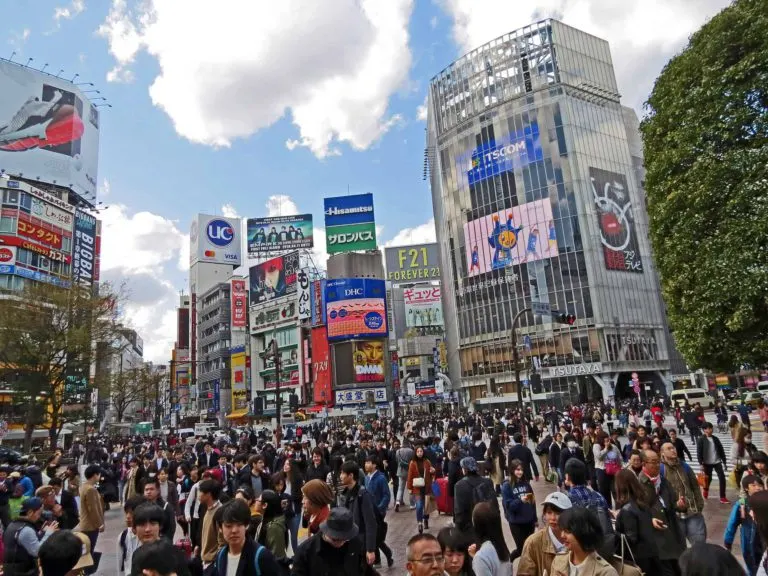
Day 1
Shibuya Scramble Crossing
We start our itinerary at one of Tokyo’s top sights, Shibuya Crossing.
Getting There
Shibuya station is one of Tokyo’s major stations. You can get there with the Tokyo Metro (Ginza, Fukutoshin & Hanzomom Lines) and with JR (Yamanote & Saikyo Lines).
At the station follow the signs for the Hachiko exit.
Shibuya Crossing is Tokyo’s most renowned intersection. It is famous for its immense size and the mesmerizing chaos that unfolds as pedestrians flood the streets from all directions when the traffic lights turn red. Hundreds or maybe even thousands of people cross the street at the same time.
The square is surrounded by towering neon billboards and vibrant advertisements. This place truly embodies the essence of modern Tokyo.
Hachiko Statue
Due to the constant hustle and bustle on the square and the intersection, the statue of Hachiko is almost unnoticeable. Hachiko is Tokyo’s most famous dog and he holds a special place in the hearts of both locals and visitors alike. The statue pays tribute to this incredibly loyal Akita dog.
Hachiko’s story dates back to the 1920s when he would faithfully wait for his owner, Professor Hidesaburo Ueno, at Shibuya Station every day. Sadly, Professor Ueno passed away unexpectedly, but Hachiko continued to wait for him faithfully at the station every day for nearly a decade, capturing the hearts of many.
The story has even been made into a movie, Hachiko, a dog’s tale.
It’s a rather small statue and it is not that far from the station’s exit. Don’t worry if you don’t directly see it, we had to look for a while before we found it.
Why we recommend this
The moment when the pedestrian lights turn green and the crowds start moving is, in a word, impressive. You may have seen it on TV, the intersection often appears in films. But being part of it yourself is a completely different experience.
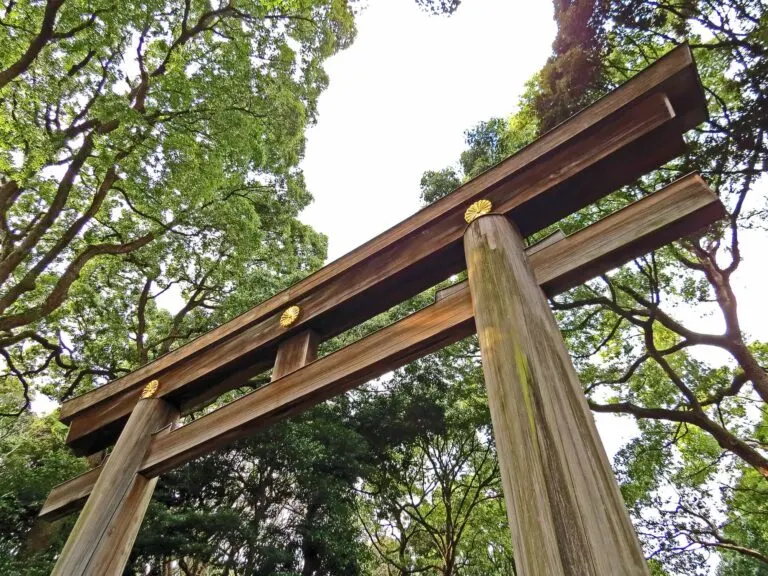
Meiji Jingu
Getting There
Take the JR Yamanote Line at Shibuya station and head towards Harajuku station. (1 stop)
At the station follow the signs for the west exit. The entrance of Meiji Shrine is right across the street.
Meiji Shrine is a remarkable shrine. It’s situated in Yoyogi Park, a 170-acre oasis of green in the heart of this densely populated metropolis.
The entrance of the shrine grounds is marked by a massive 12-meter-high wooden torii gate. From there, a wide forested path leads to the main temple sanctuary.
Once at the temple you no longer hear the sounds of the city. It is a real oasis of peace.
Meiji Jingu is one of Japan’s most popular shrines and if you’re lucky you might spot a traditional Shinto wedding as this Shrine is a popular wedding venue.
Why we recommend this
This is probably the most beautiful Shrine in Tokyo, with a grand Torii gate and located in a beautiful park.
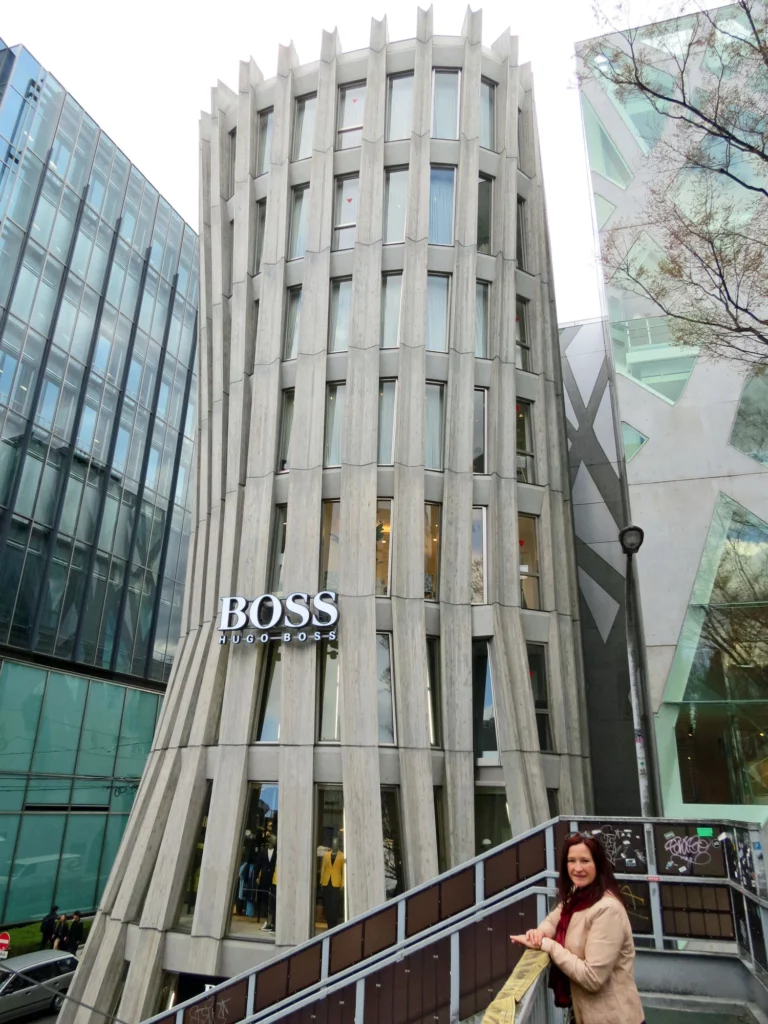
Omotesando & Harajuku
We leave the park along the same road and find ourselves back at Harajuku Station.
The wide avenue to the right of the station is Omotesando, a shopping street for a high-heeled clientele with boutiques from Dior, Hermès, Burberry, and the like.
Maybe not exactly the place to go shopping. We therefore recommend that you pay particular attention to the buildings and not so much to the shop windows.
Notable buildings are those of Dior, Boss, Tod’s, Prada and Dior. The entrance to Tokyu Plaza, a small shopping center, is also quite impressive.
If you walk into one of the side streets you suddenly enter a completely different world. These narrower and colorful streets are lined with hipper shops frequented by youth.
Harajuku has become synonymous with avant-garde street fashion and serves as a hub for creative expression and individuality.
The main street is Takeshita Street. It is a bustling pedestrian-only street packed with an array of shops, boutiques, and cafes. Due to its popularity among tourists the street now also has some tourist-oriented shops.
Nearby streets worth exploring are Cat Street and Meiji Street. You will find clothing stores that cater to alternative styles, cosplay, vintage fashion, and the latest trends.
Harajuku is also known for its vibrant street art and pop culture. Numerous walls and buildings are adorned with colorful murals, graffiti, and anime-inspired designs.
And you can’t visit Harajuku without tasting the famous mouthwatering crepes and cute character-themed sweets.
Why we recommend this
In Tokyo, teenagers are not ashamed to walk around in striking showy clothes. Chances are you’ve already seen some of them. If that is not the case, that will undoubtedly change if you stroll through the shopping streets in Harajuku.
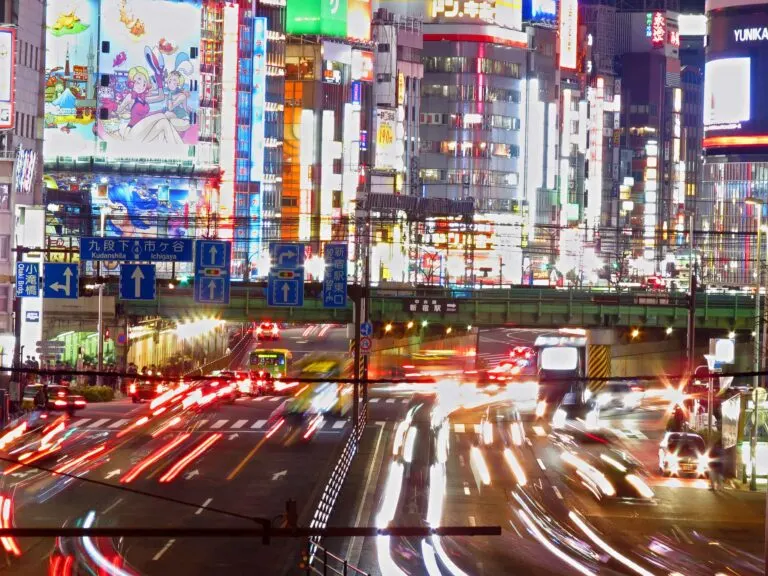
Shinjuku
We will end day 1 at Shinjuku at the heart of Tokyo. The district is home to some of Tokyo’s tallest buildings and is known for its vibrant nightlife scene.
Getting There
Depending on where you are after exploring Harajuku, you can go to Harajuku Station to catch a JR train to Shinjuku Station, or to Omote-Sando Station where you can catch a subway to Shinjuku Station.
In Shinjuku you will find numerous restaurants and after a satisfying meal, you have the opportunity to explore the vibrant nightlife scene if that piques your interest.
Kabukicho is Tokyo’s largest entertainment district. It comes alive after dark with its vibrant neon lights, bars, clubs, and karaoke establishments.
Even if you don’t want to go on a bender it’s worth exploring the streets of Kabukicho to soak up the atmosphere. Don’t let its dodgy reputation stop you, we never felt unsafe. It may be one of the unsafest neighborhoods in Tokyo but that can be said for any entertainment district in a large city.
If you’re exploring the area it is worth making a small detour to Piss Alley. An iconic alley lined with small eateries. If you are lucky enough to have room somewhere you can taste the delicious Yakitori. Don’t count on it though, these restaurants are very popular with locals and tourists alike.
Another area worth exploring is Golden Gai, a well-preserved entertainment district bordering Kabukicho that is still very much like it was post-war.
The streets are adorned with numerous quaint pubs, characterized by their small size. Many of these cozy establishments have limited seating capacity, some can accommodate no more than 10 customers. Due to their intimate nature, many of these pubs prioritize serving their loyal and regular clientele. As a tourist, you’re often not welcome.
Some are however open to foreigners and those can be recognized by the English menus outside.
Why we recommend this
Shinjuku is where our Japan adventures once started and is still the image that comes to mind when we think of Tokyo. We find the lively streets with the bright neon signs so typical of the city.
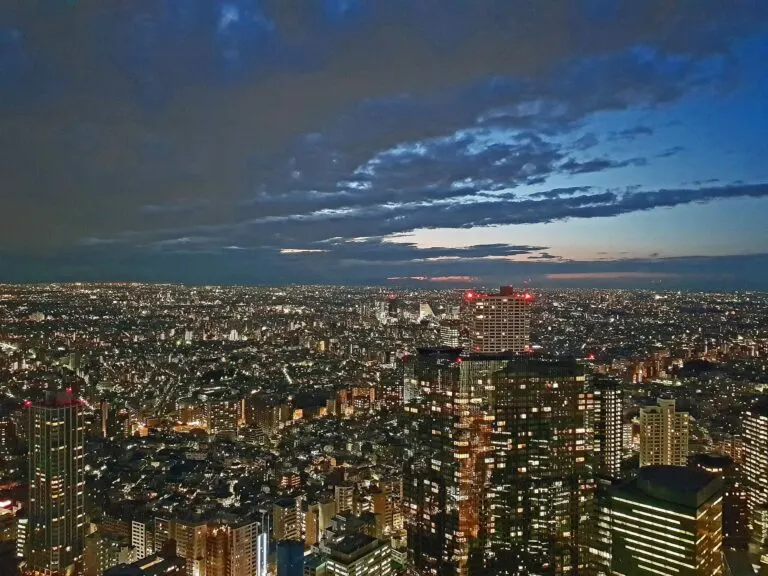
Tokyo Metropolitan Government Building
This is our last stop before we call it a day. You will undoubtedly be tired, but believe me, it’s worth it.
Getting There
The Tochomae stop of the Oedo Subway Line (Toei) is located directly underneath the building. It is 1 stop from Shinjuku station.
Both towers of this landmark building have an observation platform on the 45th floor. From a height of 202 meters, you have a captivating view of the city.
Witnessing the mesmerizing nighttime scenery of Tokyo is truly a remarkable experience. The city comes alive with an array of vibrant lights that stretch as far as the eye can see in all directions.
Why we recommend this
In Tokyo you can choose from many viewing platforms, but only 1 is free. And just because te view is free doesn’t mean it’s worthless, on the contrary. We found the view breathtaking. When we were there, queuing was not too bad either. Definitely worth it!
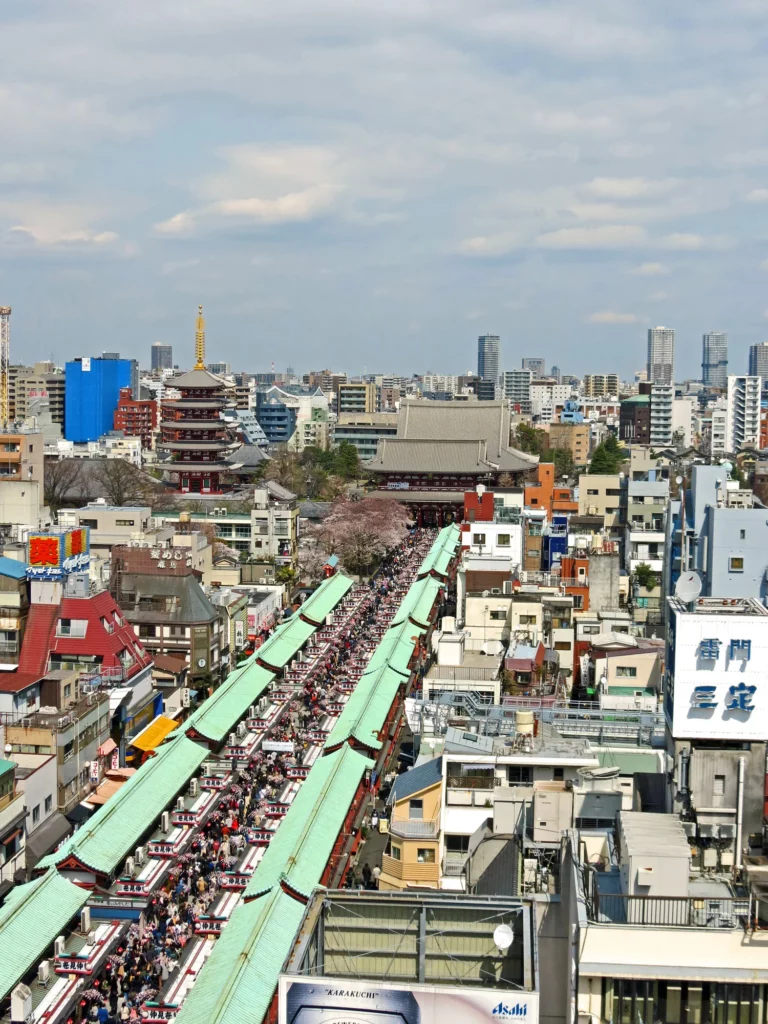
Day 2
Sensō-Ji Temple
We start the second day at an important historical landmark of the capital. The Sensō-Ji Temple dates back to 645 AD and is the oldest temple in the city.
Getting There
Take the Metro to Asakusa. It is served by the Ginza and Asakusa Line.
Coming from Asakusa Station you will approach the temple through the Nakamise shopping street. The shopping street is lined with traditional stalls selling all kinds of souvenirs, crafts, and local snacks. It seems to be busy any time of the day.
At the head of the street is the iconic Kaminarimon Gate. You can’t miss the giant paper-mache statues of the gods of wind and thunder. Both are original statues although they have undergone an almost complete reconstruction around 1960.
The other 2 statues that are on the inside of the gate were added in 1978. They represent the Buddhist god Tenryū and the goddess Kinryū.
At the end of Nakamise-dori stands the Hondo, also called Kannon-do, the main hall of the Senso-Ji temple. To the left of the main hall you will see an impressive five-storied pagoda and to the right is a much more recent Shinto shrine.
The Shinto shrine is called the Asakusa-jinja Shrine. It provides a contrast to the Buddhist temple and shows the harmonious coexistence of Shinto and Buddhist beliefs in Japan.
If you’re visiting in March or April be sure to also visit the Denboin garden, the private garden of the temple’s abbot. It’s only open to the public during these months although the exact dates vary every year.
Why we recommend this
Personally, we can’t get enough of the beautiful temples in Japan. This is one of the most impressive in Tokyo and it is also the oldest. We took a walk here with a local guide who could tell us a lot about the rich history and symbolism. Highly recommended.
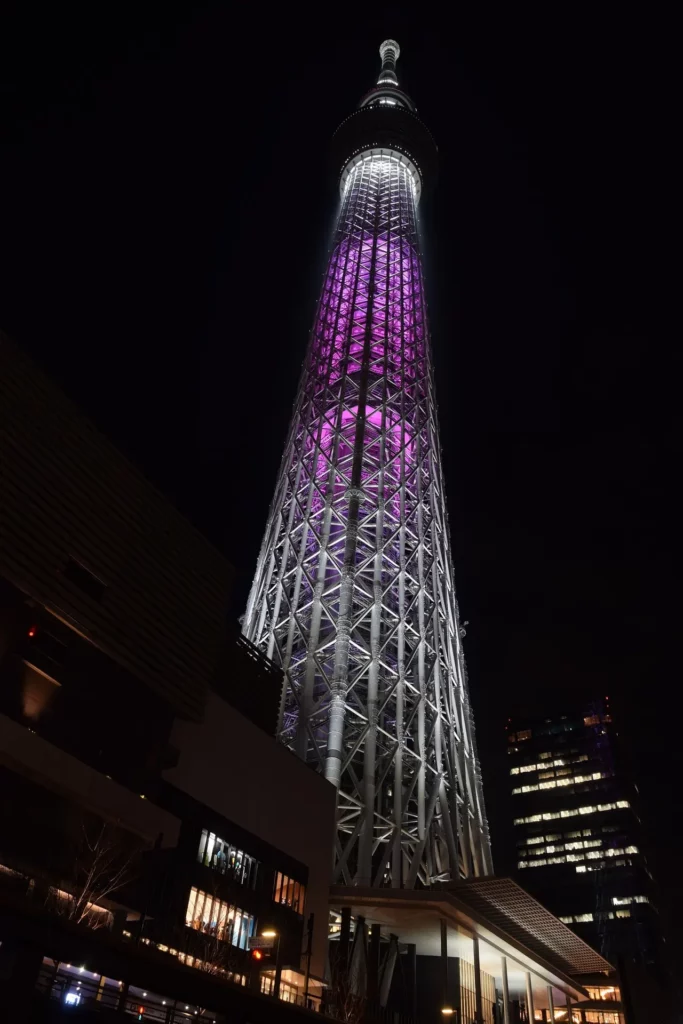
Tokyo Skytree
Asakusa used to be Tokyo’s prime entertainment district but after it was severely bombed during World War 2 it lost some of its popularity. Although it was completely rebuilt, its heyday never returned.
In order to attract more visitors, it was decided to include a standout landmark in the district. This would serve as an attraction and draw crowds to the area. And they have succeeded with flying colors.
The construction of the Tokyo Skytree started in 2008 and was completed in 2012. At 634 meters, it is the tallest structure in Japan and one of the tallest towers in the world. In the opening week alone it attracted over a million visitors, nowadays around 4 million people make their way up to the observation platforms every year.
Getting There
Head back to the Asakusa Station. There you can take the Asakusa Line to the Tokyo Skytree or the Tobu Skytree Line. Tobu is a private railroad so they don’t accept the JR Pass or the Tokyo Metro Pass.
The tower has two observation platforms, the first is situated at a height of 350 meters and contains a café and restaurant. The second platform is an additional 100 meters higher.
Both platforms offer breathtaking views over the city.
You can choose to visit only the first observation platform or both. There can be long lines so we recommend booking skip-the-line tickets online in advance.
Check prices and availability for Tokyo Skytree Skip-The-Line tickets:
Tokyo Skytree
Why we recommend this
This is the highest tower in Japan and one of the highest in the world. From the 2 observation platforms you have a beautiful view of the city. After Tokyo by night yesterday, you can now see this vast city beneath your feet in daylight. Need we say more?
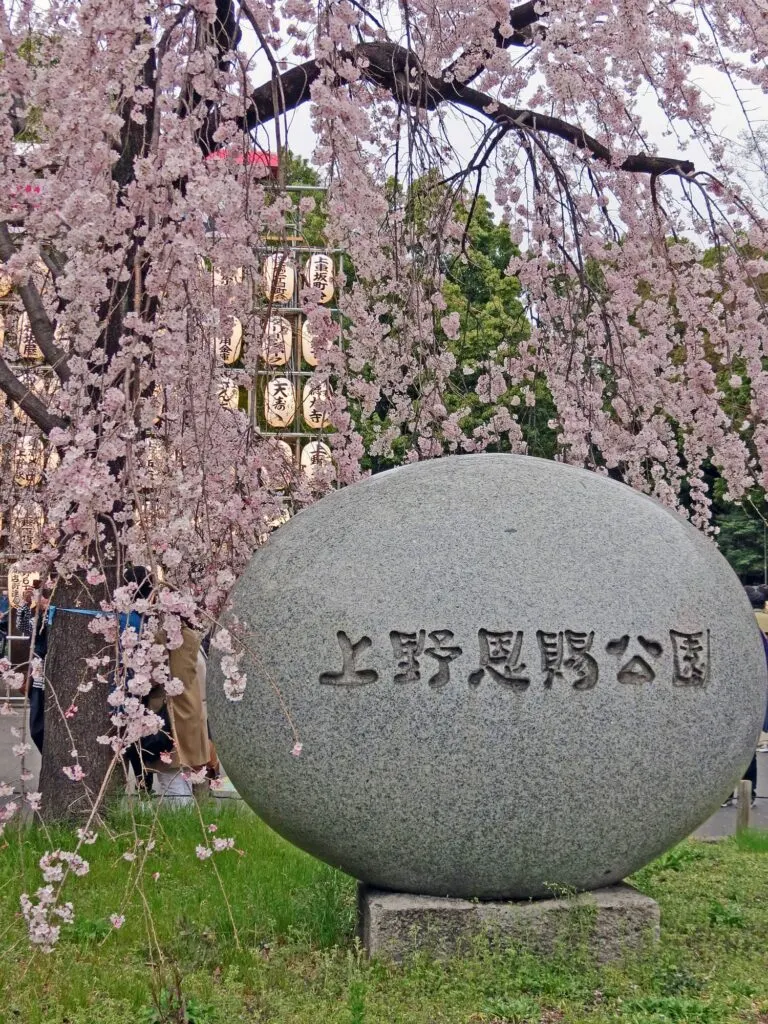
Ueno Park
Getting There
First make your way back to Asakusa station with the Asakusa Line or Tobu Skytree Line and then hop on the Ginza line to Ueno station.
Ueno park is Tokyo’s largest public park. It is always worth a visit, but if you are in Tokyo during the Sakura season it’s an absolute must-see.
Every year, during the Sakura season, the park is home to the Ueno Park Cherry Blossom Festival. The festival attracts huge crowds who gather to enjoy hanami (flower viewing) parties under the blooming cherry trees, a cherished tradition in Japan.
You can’t help but be amazed by the lively atmosphere surrounding this beautiful spectacle in Japan. All the fairly wide paths in the park are jam-packed and the masses explore the park shoulder to shoulder.
It may not be the peaceful experience that you had in mind when you think of a visit to a park but it offers a glimpse into one of many traditions that this country has.
Follow the crowd to Lake Shinobazu and see how the locals rent paddleboats to take Instagram-worthy selfies with the blossoms. But you don’t necessarily have to get in line for a paddleboat, the trails bordering the lake have some of the best places to admire the cherry trees.
Why we recommend this
A short walk in beautiful Ueno Park is ideal for relaxing and escaping Tokyo’s urban jungle. You will not find peace here during the Sakura season, but then the park is definitely worth a visit. In the first instance to see the blossoms, but even more to see the Japanese partying with their hanami parties. Such a hustle and bustle, an experience we won’t soon forget.

Akihabara
Getting There
At Ueno station take the JR Yamanote Line or the Hibiya Line (Tokyo Metro) to Akihabara station.
Akihabara is also known as Electric City. It’s the place to go for all your electronics. It’s a lot of fun to browse around these stores, they sell all kinds of gadgets, some of which were unfamiliar to us.
I have to admit that I’m a big fan of the luxurious Japanese toilets. I must honestly say that I think it is a shame that they are virtually nowhere to be found abroad. If you’re a fan too, this is the place to buy one. 🙂
You can start your journey of discovery in the large Yodobashi store near the station.
In addition to electronic stores, the district is also home to anime and manga stores and maid cafés. We spent quite some time in the Mandarake Store, a store that specializes in all kinds of manga-related goods.
The store is filled to the brim with a wide selection of comic books, video games, posters, DVDs, and action figures. To the extent that you had to be careful when moving around.
As you wander around Akihabara, you will also come across the maids advertising their maid cafes. They’re often dressed like Victorian-era French maids or as popular anime characters.
If you want to experience what maid cafés are all about you should have a drink at one. Unless you speak Japanese it is best to choose either the @home café or Maiddreamin where the maids speak (a little) English.
Why we recommend this
Admit it, when we think of Japan we think of electronic gadgets and manga (comics). You will find both in abundance in Akihabara. The district has become the epicenter of Otaku culture (manga, anime, video games, …) and even though we will never become huge fans of the genre, we still found it very worthwhile to spend a few hours immersed in the craziness that surrounds it.
Conclusion
This ends our 2-day exploration of Tokyo. Obviously, you haven’t seen everything during these 2 days, but hopefully, you have gotten a taste of this city and you feel the itch to come back again to explore the rest.
Getting Around Tokyo
The best (read: cheapest and fastest) way to get around Tokyo is by metro. All of the sights included in this 2-day itinerary can easily be reached by metro.
Two different companies operate Tokyo’s Metro Lines: Toei and Tokyo Metro.
We recommend getting a Tokyo Subway Ticket for this itinerary. You can get one for 1, 2, or 3 days and the ticket gives you unlimited rides on all metro lines, both Toei and Tokyo Metro.
If you buy a pass online you simply need to scan the QR code that you receive at one of the automated ticket machines and your tickets will be issued.
Get your Tokyo Subway Ticket:
Buy on Klook
Read Also:
Where to Stay
Shinjuku is a good base for this itinerary. There are several hotels close to Shinjuku station. Staying in Shinjuku will save you a long train or subway ride after your tiring and long first day.
A hotel that we can recommend is the Hilton Tokyo.
Take a look at this where to stay in Tokyo post for other options.
Leave a Reply